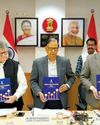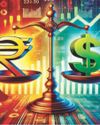
The World Bank began classifying its member countries based on per capita gross national income (GNI) at constant prices (taking away the influence of changes in price level) for the purpose of concessional lending The GNI is defined, as total income earned by a nation’s people and businesses, including investment income, regardless of where it was earned. It also covers money received from abroad such as foreign investment, inward remittances and economic development aid. There are four categories based on ranges of average per capita GNI as follows:
(i) Low income
(ii) Low middle income
(iii) Upper middle income
(iv) High income
These classifications and income limits are updated every three years. The latest announcements categorizing the World Bank member countries are of July 2023 for FY 2024 in US dollars.
Table 1 shows the ranges of the four categories.
Table 2 shows average per capita GNI for India as well as other Indian subcontinent neighbors and Southeast Asian countries.
Nepal is classified as the only low-income country in the Indian subcontinent. All other five subcontinent countries are low middle income countries. In Southeast Asia, no country is in the low-income category. All other countries are low middle income countries except Malaysia. Malaysia is in the upper middle country, with a current per capita income (GNI) of $11,830. Singapore in South East Asia, is the only country, which is generally known as developed or advanced country at a high average per capita income ($67,353).
Malaysia is expected soon to graduate to become a highincome country from the upper-middle income class, when its average per capita income is expected to hit 13,386 in 2027.
Many people are wondering when India would become a high income country.
Diese Geschichte stammt aus der June 01 - 30, 2024-Ausgabe von BUSINESS ECONOMICS.
Starten Sie Ihre 7-tägige kostenlose Testversion von Magzter GOLD, um auf Tausende kuratierte Premium-Storys sowie über 8.000 Zeitschriften und Zeitungen zuzugreifen.
Bereits Abonnent ? Anmelden
Diese Geschichte stammt aus der June 01 - 30, 2024-Ausgabe von BUSINESS ECONOMICS.
Starten Sie Ihre 7-tägige kostenlose Testversion von Magzter GOLD, um auf Tausende kuratierte Premium-Storys sowie über 8.000 Zeitschriften und Zeitungen zuzugreifen.
Bereits Abonnent? Anmelden

NITI Aayog launches the "Fiscal Health Index 2025"
The report also highlights state-specific challenges and areas for improvement.

Convergence of Science and Spirituality ensures a healthier future
Speech of Dr. Prasun Mishra, President AAPM, Chair, WISE Capitals on the 15th World Confluence of Humanity, Power and Spirituality on 27th December 2024

The Crisis in Bolivia
Political leaders must put aside their rivalries and focus on stabilizing the economy.

Assam Government hosts successful Investors' Roadshow in Kolkata
The Assam Government organized a highly successful Investors' Roadshow at Hotel Taj Bengal, Kolkata, serving as a prelude to the much-anticipated \"Advantage Assam 2.0: Investment and Infrastructure Summit 2025.\"

India needs to reform both global and domestic policies to boost core sector growth
The core sector, consisting of key industries such as petroleum and refining, electricity generation, steel production, coal mining, crude oil, natural gas, cement, and fertilizers, requires comprehensive policy reforms to enhance its contribution to the overall industrial output.

Understanding the implications of India's revised GDP growth outlook
India's GDP growth rate forecast for FY25 has recently been revised downwards by several institutions, reflecting a broader economic slowdown.

Achievements and Challenges of a Decade of 'Make in India'
The 'Make in India' initiative, launched in 2014, marks a significant milestone as it completes a decade of efforts to position India as a global manufacturing hub.

Indian Rupee depreciation against the dollar: Why it's not a cause for concern
The daily fluctuations in the exchange rate of the Indian rupee against the dollar have kept the media busy, with many analyses trying to determine the reasons behind its depreciation.

EIILM-Kolkata launches 'MBA Cloud ERP with SAP' in Eastern India
EIILM-Kolkata, a leading Management Institute of Eastern India has taken a historic step towards uplifting the quality of management education in this part of the country.

The IMF World Economic Outlook, January 2025 - An analysis/review
On January 17, 2025, the International Monetary Fund On January 17, 2025, the International Monetary Fund (IMF) released its World Economic Outlook (WEO) update, titled \"Global Growth: Divergent and Uncertain.\"